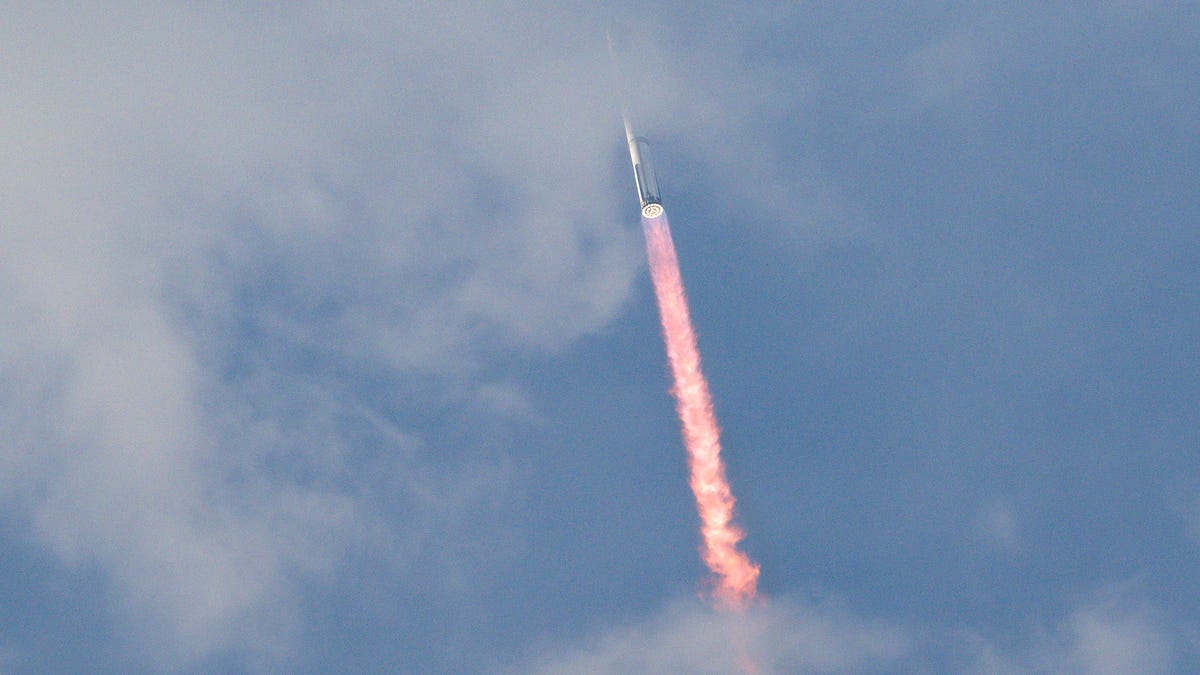SpaceX Calls Mission 3 a Success, Despite Losing Starship: How to Rewatch
On its third attempt, SpaceX launched its Starship and cruised into space, but lost the rocket after reentry to Earth.

SpaceX launched its third Starship mission from Starbase in Boca Chica, Texas, on March 14, 2024.
SpaceX launched its third Starship mission on Thursday, with the space exploration company owned by Elon Musk forging ahead after the first two attempts exploded after takeoff. SpaceX considers those first two missions successful, thanks to the data it was able to collect, and the third mission was the most successful of the bunch.
Shortly before 9:30 a.m. ET Thursday, the company posted three words to the Musk-owned X social media site: "Liftoff of Starship!" A 36-second video showed the rocket engines igniting and then Starship rising amid a cloud of exhaust smoke and up into the sky.
But the rocket did not complete the round trip, as you can see by rewatching the full test flight. "The ship has been lost. No splashdown today," Dan Huot of SpaceX communications said on the stream. "But we were able to get through some of the early phases of reentry."
SpaceX quality engineering manager Kate Tice noted on the stream that SpaceX wasn't intending to recover Starship anyway, and had been planning to crash it into the ocean.
Starship is arguably the most ambitious effort for Musk, who owns the satellite-based internet company Starlink along with X, EV maker Tesla and the neurotechnology company Neuralink. The Starship missions are critical to SpaceX's -- and Musk's -- goal of getting to and eventually settling the moon and Mars.
With a new flight trajectory and hopes for new data insights, the space company's third mission may prove to be its most important yet.
When did the Starship mission launch?
Starship's third mission launched on March 14. It had been pending favorable weather and a license from the Federal Aviation Administration.
How to rewatch Starship mission 3
SpaceX set up livestreams for watching the third mission. One was the SpaceX account on X, and another was the SpaceX third mission landing page. You could also watch via CNET's YouTube channel.
You can rewatch the launch on X, on the mission 3 page, or via CNET's YouTube stream embedded here.
What SpaceX achieved in Starship mission 3
SpaceX's third Starship mission was designed to test whether the spacecraft can complete certain tasks. After liftoff, the company planned to open Starship's payload door and transfer its propellant from one part of the vehicle to another. For the first time, SpaceX also attempted to relight its Raptor engine while in space, a test that could be critical for future missions as it eventually tries to propel Starship through space.
Starship took a different flight path this time around, and had planned to land in the Indian Ocean instead of the Pacific Ocean until it lost the vehicle after reentry. In a statement, SpaceX said that the new flight path was designed to maximize "public safety," but the company didn't discuss how.
The new flight path also paved the way for SpaceX to try "in-space engine burns," a reference to the company attempting to reignite the Raptor engine in space.
"Huge congratulations to the entire team for this incredible day: clean count (glad the shrimpers could get out in the nick of time!), liftoff, hot staging, Super Heavy boost back and coast (and likely a couple engines making mainstage during landing burn!), clean ship 'insertion' and coast, payload door cycling and prop transfer demo (to be confirmed!), and ship entry!" SpaceX President Gwynne Shotwell posted on X following the launch, naming the successful components of the test.
The mission was slated to last for 1 hour, 15 minutes. Previous missions, if completed, would have lasted 90 minutes.
What happened in the previous missions?
April mission: Forced detonation
The first Starship mission launched in April 2023. Early on in the mission, the two stages of Starship -- the reusable upper stage, called Starship, and its Super Heavy first-stage booster -- were supposed to separate. That didn't happen, and for safety reasons, the SpaceX team was forced to detonate the vehicle just 4 minutes into the mission.
November mission: Explosion due to liquid oxygen
In November 2023, Starship launched on its second mission. That time around, Starship was able to separate its two stages and it reached nominal first-stage engine burn. However, Starship exploded 8 minutes after launch when it tried to vent its liquid oxygen. Oddly, the explosion may not have needed to happen. Earlier this year, Musk said on a real mission carrying payload -- meaning the materials a spaceship carries to perform its scientific mission -- liquid oxygen wouldn't be onboard.
"Starship's second flight test achieved a number of major milestones and provided invaluable data to continue rapidly developing Starship," the company wrote on its site. "Each of these flight tests continue to be just that: a test. They aren't occurring in a lab or on a test stand, but are putting flight hardware in a flight environment to maximize learning."
Corinne Reichert contributed to this report.

